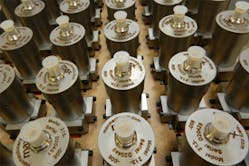By Paul Hock, Manager of Product Development, Max Machinery
Paul Hock is a guest contributor to the FlowStream blog. Mr. Hock has been with Max Machinery since 1986, serving as head of marketing and product development for the last 17 years. He has degrees in Mechanical Engineering and Business Administration from UW-Milwaukee. T
EDITOR'S NOTE: Visit the Flow Control Magazine LinkedIn group for an ongoing discussion about this blog post. http://flwctrl.com/SXCe53
Positive-displacement meters have taken a little flak from manufacturers of competitive technologies. This article seeks to clear up a few of the misconceptions fueled by these claims.
A quote found online states:
“These [Positive-Displacement] meters also have lots of moving parts, which means many potential wear points, and they can clog easily.”
An interesting glimpse at positive-displacement flowmeters, but it must be said that a few important details have been left out.
To start with, it is important to remember precision positive-displacement (PD) flowmeters are engineered to have moving parts. Gaps and tolerances are engineered with such clockwork precision that blow-by is not an issue. Furthermore, the “moving parts” referenced above, are the very reason PD meters can handle flowrates as low as 10 drops per minute—without zero effect (zero effect being unique to Coriolis).
Other claims about volumetric (PD) meters would lead you to believe that there are limited applications outside of oil and hydraulic fluids. In fact, PD meters are capable of running fluid from 0.4 cP (viscosity of Freon) to 100,000 cP (viscosity of Asphalt) in intermittent, continuous, and bidirectional systems; the meters can be installed in-line and, once running, require little-to-no maintenance.
Positive-displacement meters, unlike complex metering devices—Coriolis, for example—do not require constant monitoring to ensure the meter has not wandered; shifting out of calibration due to adjustments in flow speed, or because of stopping and restarting a system. A disadvantage to meters with no moving parts is no set volume to reliably report at ultra-low flows.
As far as claims that PD meters “can clog easily,” PD meters do have some limitations with certain fluids—just as there are many fluids and flowrates inappropriate for Coriolis, Turbine, Ultrasonic, and Magmeters. The best bet is to contact the manufacturer, compare optional seals, coatings, materials of construction, and pricing.
Pricing is a topic often not approached in meter selection articles. Many of the technologies “without moving parts” require complex calibrations and continuous monitoring that stretch the limitations of many budgets. Somehow, the flowmetering industry has been able to market this “ability” to constantly monitor the potential calibration slip of its meters as a benefit, but really it can be a hidden cost.
Calibration is not the only hidden cost in today’s industrial setting. A reliable meter—that can be left to operate for years, or fit into any calibration schedule—can eliminate the time demands requiring highly skilled engineers to babysit a flowmeter. It is the manufacturer’s job to ensure this is not required of the operator. Complexities of design should not fall on the installer to accommodate. A flowmeter is not and should not be the most complex portion of an engineer’s job—it should be precise, accurate and reliable.
The factor of calibration is important, it is not unheard of in the precision PD meter market to have a meter handling fluid rates of 20 cc/min with a viscosity near honey, consistently proving an accuracy of 1 percent—without calibration—sometimes after 10, 20, or even 30 years with no calibration. This reliability is achieved only through innovative materials, engineering, and time invested in the technology.
If you are considering which technology is right for you, here are some reliable resources to provide a better understanding of positive-displacement meters:
EDITOR'S NOTE: Visit the Flow Control Magazine LinkedIn group for an ongoing discussion about this blog post. http://flwctrl.com/SXCe53




